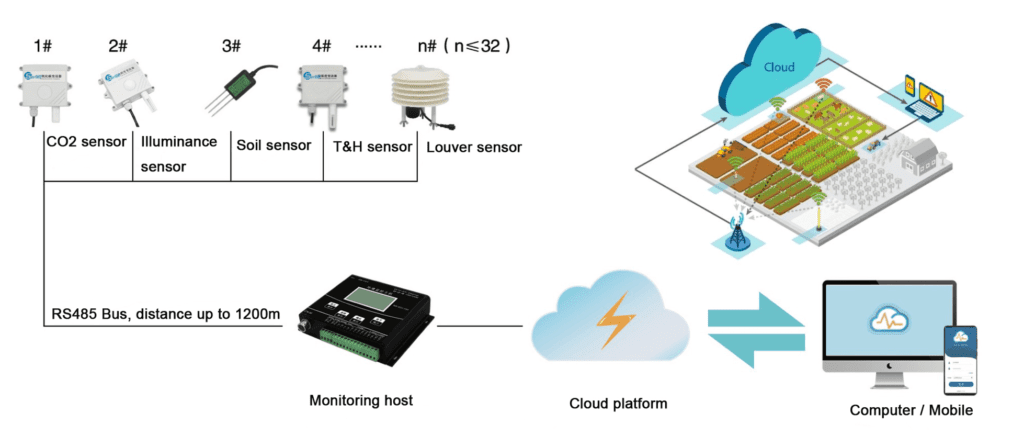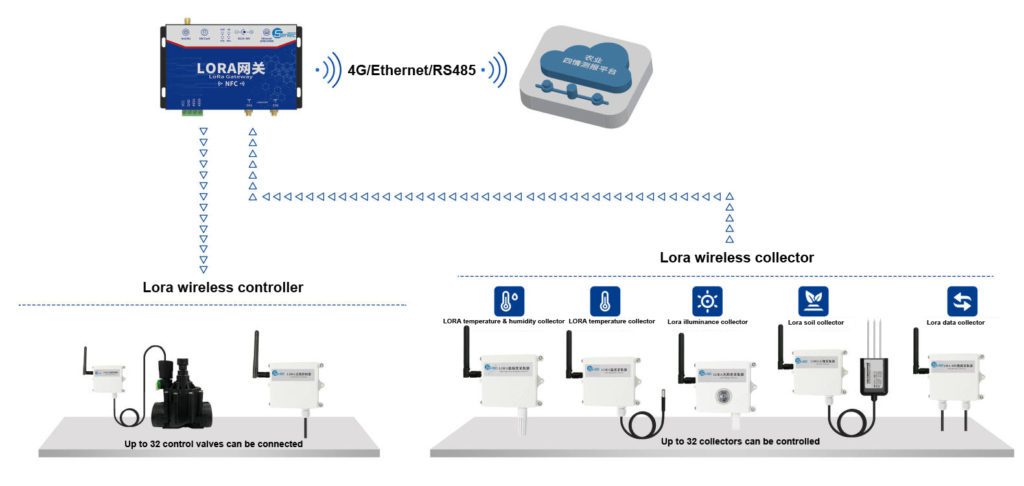In today’s world, Internet of Things (IoT) is not a new term. It is a revolutionary technology that has been transforming various sectors, and agriculture is one of them. IoT and Agriculture have formed a unique alliance known as Smart Agriculture. The concept of IoT in agriculture converges technology with traditional farming practices to increase efficiency and productivity.
Smart Agriculture is an innovative approach that employs IoT devices like sensors, automated machines, and real-time tracking systems to monitor agricultural activities. It aims to enhance the quality of farming and optimize the use of resources. By harnessing the power of IoT, Smart Agriculture aims to make farming more precise, automated, and data-driven.
In essence, IoT and Smart Agriculture are the catalysts for a major shift in the farming landscape. They are opening doors to new possibilities and opportunities in agriculture, transforming the way we grow and manage our food.
The Importance of IoT in Agriculture
IoT in Agriculture has a significant role in shaping the future of farming. Through advanced sensors, drones, and real-time data analytics, IoT provides farmers with actionable insights to make informed decisions. This helps in reducing waste, improving yield, and increasing overall agricultural productivity.
Moreover, IoT for agriculture enables predictive analysis for weather conditions, soil quality, crop growth, and pest infestation. By providing real-time information, it helps farmers in proactive decision-making, thus minimizing the risks associated with unpredictable farming variables.
In the context of sustainable farming, IoT Agriculture plays an integral role in resource management. IoT devices can monitor water usage, manage irrigation systems, and optimize fertilizer application, thus promoting sustainable farming practices and reducing environmental impact.
Key Concepts: What is Smart Farming?
Smart Farming, a subset of Smart Agriculture, is a holistic approach to farming using IoT technology. It is an integration of advanced technologies into the traditional farming practices to increase the quantity and quality of agricultural products.
At the core of Smart Farming is data. IoT devices and sensors gather vast amounts of data from the farm – about the weather, soil, crops, livestock, and even machinery. This data is then processed and analyzed to provide valuable insights, which farmers can use to make informed decisions and strategies.
A Smart Farm utilizes IoT devices for precision farming, automated irrigation, real-time livestock monitoring, and predictive analysis. This not only improves the efficiency and productivity of the farm but also makes farming more sustainable and environment-friendly.
IoT based Smart Agriculture Monitoring System: An Overview
An IoT based Smart Agriculture Monitoring System is a comprehensive solution that helps farmers monitor and manage their farming operations in real-time. It involves the use of IoT devices like sensors, actuators, and gateways to collect, process, and transmit data from the farm to the farmer.

The system can monitor various parameters such as soil moisture, temperature, humidity, light intensity, and pH level. This data is then analyzed to provide valuable insights about the farm’s condition and the optimal requirements for crop growth.
Moreover, the IoT based Smart Agriculture Monitoring System can automate various farming operations. For instance, it can automatically turn on the irrigation system when the soil moisture level drops below a certain level. This not only saves time and effort but also optimizes the use of water.
Innovative Smart Agriculture Project Ideas
There are numerous innovative Smart Agriculture project ideas that leverage IoT technology to transform the farming landscape. For instance, precision farming using drones is a project idea that involves the use of drones to monitor crop health, identify disease hotspots, and apply fertilizers or pesticides precisely.
Another innovative project idea is the IoT based livestock monitoring system. This involves the use of IoT devices to monitor the health and location of livestock in real-time. It can help in early detection of diseases, ensuring the well-being of the livestock, and reducing losses.
Smart irrigation is yet another project idea that uses IoT devices to monitor soil moisture and automate irrigation. This not only saves water but also ensures the optimal growth of crops. Similarly, Smart Greenhouses is a project idea that uses IoT to control and monitor the climate inside the greenhouse, ensuring optimal conditions for plant growth.
The practical application of wireless sensors in smart agriculture
In the process of agricultural practical application, by using the wireless network to obtain the overall environmental information in the application area, not only can the data be summarized and sorted, but also environmental information can be collected and analyzed. In addition, the application of wireless sensors can not only monitor the overall environmental information, but also sense the environmental data information of agriculture and production in the overall area through a single node, and comprehensively improve the accuracy of the monitoring system itself. Five practical applications of wireless sensors in agriculture:
Smart Agriculture Project Ideas: applied to outdoor fields
Wireless sensors can collect real-time agricultural environmental information such as air temperature and humidity, soil temperature and humidity, CO2 concentration, soil pH value and light intensity in the target monitoring area, providing an effective solution for agricultural environmental monitoring and helping the agricultural sector Develop ways to increase crop yields more efficiently.
Smart Agriculture Project Ideas: used in greenhouses
Different wireless sensors can be used to collect soil temperature, humidity, pH value, precipitation, air humidity and air pressure, light intensity, CO2 concentration and other crop growth parameters. Managers can access the cloud platform to observe various data in the greenhouse in real time. Automatic and manual adjustment of the greenhouse environment in time, Provide scientific basis for greenhouse regulation.
Smart Agriculture Project Ideas: Applied to livestock breeding
Various wireless sensors can be used to collect information on the livestock and poultry breeding environment, as well as the behavioral characteristics and health status of animals. The livestock breeding system can realize automatic temperature control, automatic ventilation, automatic data transmission and automatic alarm in the process of sow breeding by analyzing and processing the information collected by wireless sensors.
Smart Agriculture Project Ideas: Applied to fruit, vegetable and grain storage
Wireless temperature sensors play a huge role in the storage of fruits, vegetables and grains. The refrigerator implements automatic control and keeps the temperature relatively stable according to the real-time parameter values of the temperature sensor in the cold storage. Reduce the temperature in the storage warehouse, maintain the humidity, and maintain a reasonable ratio of relative humidity (RH), O2 concentration, CO2 concentration, etc. through gas regulation, wireless temperature sensor, wireless humidity sensor, wireless O2 concentration sensor, wireless CO2 concentration sensor in the storage room. It can collect data in real time to ensure a suitable storage and preservation environment to achieve the preservation effect.
Smart Agriculture Project Ideas: Applied to aquaculture
The application of the Agricultural Internet of Things in aquaculture is mainly manifested in the automatic monitoring of various indicators of the breeding environment with the help of various wireless water quality sensors, and by controlling the corresponding equipment, the breeding environment is maintained within the scientific range. For changes in the environment, the system will automatically record and notify the administrator through SMS. The administrator can also view the scene and data of the breeding environment in real time through the background of the supervision system or the system mobile app.
More solutions: Smart agriculture and smart farming
Case Studies: Successful IoT Agriculture Projects
There are several successful IoT Agriculture Projects that have demonstrated the potential of Smart Agriculture. One such project is John Deere’s precision farming solution. They have integrated IoT sensors and GPS into their machinery to enable precision farming. This has helped farmers in reducing input costs and increasing yield.

Another successful project is the Smart Vineyard project in California. This project uses IoT sensors to monitor soil moisture, temperature, and humidity in the vineyard. The data collected is used to optimize irrigation and improve grape quality, leading to better wine production.
The Smart Poultry Farming project in China is another success story. The project uses IoT devices to monitor the health and environment of poultry farms. This has resulted in improved poultry health, increased productivity, and reduced losses.
Case study: Design of agricultural greenhouse IOT monitoring system
The Role of Digital Farming in Transformative Agriculture
Digital Farming, an integral part of Smart Agriculture, involves the use of digital technologies to improve agricultural productivity and sustainability. It goes beyond the use of IoT devices and includes technologies like Big Data, Artificial Intelligence, and Machine Learning.
Digital Farming transforms agriculture by enabling precision farming. It allows farmers to apply the right amount of inputs at the right place and time, thus reducing waste and increasing yield. Moreover, digital farming provides farmers with real-time data and predictive analytics, enabling proactive decision-making and risk management.
Digital Farming is also crucial in fostering sustainability in agriculture. By optimizing resource usage and reducing waste, it promotes sustainable farming practices. Moreover, digital farming can help in mitigating the impacts of climate change on agriculture by enabling adaptive farming practices.
Smart Farming Technology and its Impact on the Agricultural Landscape
Smart Farming Technology is revolutionizing the agricultural landscape. By integrating IoT devices into farming practices, it is making farming more precise, efficient, and sustainable.
One of the key impacts of Smart Farming Technology is the shift towards data-driven farming. Farmers are now using data to make informed decisions about crop selection, fertilization, irrigation, and pest control. This has resulted in increased yield and reduced waste.
Moreover, Smart Farming Technology is making farming more sustainable. By optimizing resource usage and reducing environmental impact, it is contributing to the sustainability of agriculture.
The Future of IoT in Agriculture: Predictions and Trends
The future of IoT in Agriculture looks promising. With advancements in technology, the adoption of IoT in agriculture is set to increase. Farmers are increasingly recognizing the immense potential of IoT in enhancing productivity, reducing costs, and promoting sustainability.
One of the key trends in IoT Agriculture is the rise of precision farming. With the help of IoT devices, farmers are now able to apply the right amount of inputs at the right place and time. This not only improves yield but also reduces waste and environmental impact.
Moreover, the use of IoT in livestock monitoring is set to increase. IoT devices can help in real-time tracking of livestock, early detection of diseases, and improving the well-being of livestock.
Conclusion: The transformative power of smart agriculture
In conclusion, the transformative power of Smart Agriculture is immense. By harnessing the potential of IoT and Smart Farming Technologies, we are witnessing a paradigm shift in the agricultural landscape.
From precision farming to automated irrigation, from real-time livestock monitoring to predictive analytics, Smart Agriculture is revolutionizing farming practices and making them more efficient, productive, and sustainable.
The future of agriculture undoubtedly lies in Smart Agriculture. As we continue to embrace IoT and Smart Farming Technologies, we can look forward to a future where farming is not only productive and profitable but also sustainable and environment-friendly.











